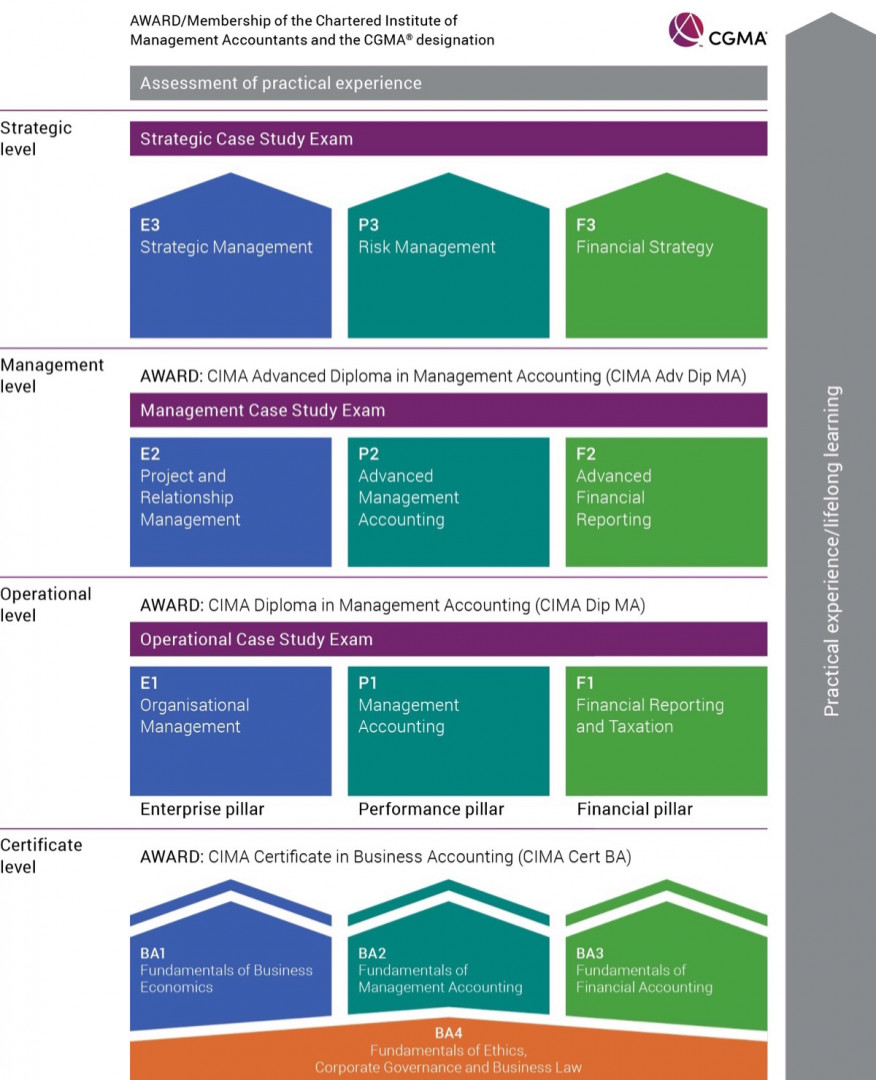Forgot Your Password?
Just enter your account email here
to have the password sent to your email.
By passing this level, you will gain the CIMA Diploma in Management Accounting. Operational level is the first level of the CIMA Professional Qualification and consists of three subject areas and a final case study assessment.
The Operational level focuses on short term decision making. You’ll be able to work with others in your organisation and use appropriate data and technology to translate medium term decisions into short term actionable plans.
After successfully completing the level, you are awarded with the part-qualified designatory letters ‘CIMA Dip MA’ and are ready to embark upon your Management Level journey.
E1 MANAGING FINANCE IN A DIGITAL WORLD
You may qualify for exemptions which let you start your studies at a level that is consistent with the knowledge and skills gained from prior learning. They provide you with the quickest route to CIMA membership.
Click below to establish any exemptions you may be awarded along with further important dates and CIMA information.
Don't Forget! As part of your journey to become an CIMA member, you must demonstrate relevant skills and experience within a real work environment. This is what CIMA'S Practical Experience Requirement (PER) is all about.
To complete CIMA and gain membership you will need to achieve a minimum of 36 months’ experience across the four knowledge areas, with a maximum of 60 months to be evidenced.
Download the per guide
Syllabus structure
The syllabus comprises the following topics and weightings:
A. Cost Accounting for decision and control: This area is about understanding why costing is done and what it is used for. It introduces candidates to the basic building blocks of costing and how to apply them in the costing methods and techniques organisations use. In a fast-changing digital world this understanding is critical and can enable candidates to develop their own ways of calculating costs when existing methods are no longer appropriate. Digital costing is introduced in this section.
B. Budgeting and budgetary control: Taken together, budgeting and budgetary control is one way the finance function enables and shapes how organisations create and preserve value. This section examines the various reasons organisations prepare and use budgets, how the budgets are prepared, the types and sources of data, the technologies used to improve the quality of budgets, how budgets are implemented and the impact on the people who work with the organisation.
C. Short term commercial decision making: Organisations cannot foresee every opportunity that might arise during their operations, so they need mechanisms by which to identify and take advantage of these opportunities as they arise. The primary objective of this section is to guide candidates in how to do this in the short term through effective decision-making. The finance function supports such decisions (e.g., pricing and product choice) using techniques such as relevant revenue and cost analysis and break- even analysis. Candidates are introduced to these techniques and the concepts that underpin the techniques. They are expected to be able to apply the techniques to support short-term decision-making.
D. Risk and uncertainty in the short term: Budgets and decisions focus on the future. This introduces uncertainties and risks that need to be identified, assessed and managed. The aim of this section is to help candidates identify, assess and manage the risks and uncertainties associated with the short term.
EXAM FORMAT
READY TO MAKE A START with rca?
Step right in and start your CIMA & RCA journey. RCA run all courses twice yearly to help keep you moving through the qualification with classes running during the spring and autumn terms for P1, on an evening and weekend basis.
INCLUDED IN YOUR P1 LIVE ONLINE/CLASSROOM COURSE
1. Face to face classes or login via the live stream, the choice is yours
2. 30-36 Hours of lectures from subject specialist tutors
3. Exam question practice throughout
4. All classes are recorded and uploaded to your online account to recap and reinforce classroom learning
5. Can't make it to a class? No problem, just catch up via your online recording
6. All learning materials included (tutor course notes, Kaplan study text & exam kit)
7. Tutor support 24/7 via Email, What'sApp or Phone
8. What'sApp group support. with tutor updates with assignments pre & post class
9. Flexible payment terms available
10.Pass guarantee...
CHECK OUT ALL P1 CLASS DATES AND PRICES HERE

Just enter your account email here
to have the password sent to your email.
This site uses essential cookies for parts of the site to operate and have already been set. Find out more about how we use cookies and how you may delete them HERE. You may delete cookies, but parts of the site will not work.
Input your email address and click the subjects you are interested in for free emails with study guidance, tips and other resources.